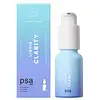What's inside
What's inside
 Key Ingredients
Key Ingredients

 Benefits
Benefits

 Concerns
Concerns

No concerns
 Ingredients Side-by-side
Ingredients Side-by-side

Water
Skin ConditioningPropanediol
SolventTranexamic Acid
AstringentDimethyl Isosorbide
SolventGlycerin
HumectantKojic Acid
AntioxidantNiacinamide
SmoothingGlycyrrhiza Glabra Root Extract
BleachingCamellia Sinensis Leaf Extract
AntimicrobialPolysorbate 20
EmulsifyingPhenoxyethanol
PreservativeHydroxyethylcellulose
Emulsion StabilisingCaprylyl Glycol
EmollientTocopheryl Acetate
AntioxidantSodium Hyaluronate
HumectantDisodium EDTA
Sorbic Acid
PreservativeCitric Acid
BufferingWater, Propanediol, Tranexamic Acid, Dimethyl Isosorbide, Glycerin, Kojic Acid, Niacinamide, Glycyrrhiza Glabra Root Extract, Camellia Sinensis Leaf Extract, Polysorbate 20, Phenoxyethanol, Hydroxyethylcellulose, Caprylyl Glycol, Tocopheryl Acetate, Sodium Hyaluronate, Disodium EDTA, Sorbic Acid, Citric Acid
Water
Skin ConditioningPropanediol
SolventGlycerin
HumectantIsodecyl Neopentanoate
EmollientSalicylic Acid
MaskingZinc PCA
HumectantTocopheryl Acetate
AntioxidantHydroxypropyl Starch Phosphate
Nigella Sativa Seed Oil
EmollientBakuchiol
AntimicrobialSalix Alba Bark Extract
AstringentDimethyl Isosorbide
SolventLeuconostoc/Radish Root Ferment Filtrate
AntimicrobialCetearyl Isononanoate
EmollientGlycol Distearate
EmollientCaprylyl Glycol
EmollientGlycyrrhiza Glabra Root Extract
BleachingAllantoin
Skin ConditioningBisabolol
MaskingLecithin
EmollientSodium Hyaluronate
HumectantHyaluronic Acid
HumectantSclerotium Gum
Emulsion StabilisingSodium Gluconate
Skin ConditioningSodium Stearoyl Glutamate
CleansingSodium Acrylates Copolymer
Phenoxyethanol
PreservativeWater, Propanediol, Glycerin, Isodecyl Neopentanoate, Salicylic Acid, Zinc PCA, Tocopheryl Acetate, Hydroxypropyl Starch Phosphate, Nigella Sativa Seed Oil, Bakuchiol, Salix Alba Bark Extract, Dimethyl Isosorbide, Leuconostoc/Radish Root Ferment Filtrate, Cetearyl Isononanoate, Glycol Distearate, Caprylyl Glycol, Glycyrrhiza Glabra Root Extract, Allantoin, Bisabolol, Lecithin, Sodium Hyaluronate, Hyaluronic Acid, Sclerotium Gum, Sodium Gluconate, Sodium Stearoyl Glutamate, Sodium Acrylates Copolymer, Phenoxyethanol
Ingredients Explained
These ingredients are found in both products.
Ingredients higher up in an ingredient list are typically present in a larger amount.
Caprylyl Glycol is a humectant and emollient, meaning it attracts and preserves moisture.
It is a common ingredient in many products, especially those designed to hydrate skin. The primary benefits are retaining moisture, skin softening, and promoting a healthy skin barrier.
Though Caprylyl Glycol is an alcohol derived from fatty acids, it is not the kind that can dry out skin.
This ingredient is also used as a preservative to extend the life of products. It has slight antimicrobial properties.
Learn more about Caprylyl GlycolDimethyl Isosorbide is a solvent and helps deliver actives into your skin. It is created from sorbitol.
As a solvent, dimethyl isosorbide helps dissolve other ingredients. This helps ensure even distribution of an ingredient. It may also be used to decrease the thickness of a product.
Studies show dimethyl isosorbide is able to penetrate skin to deliver other ingredients into the skin, making them more effective.
Learn more about Dimethyl IsosorbideGlycerin is already naturally found in your skin. It helps moisturize and protect your skin.
A study from 2016 found glycerin to be more effective as a humectant than AHAs and hyaluronic acid.
As a humectant, it helps the skin stay hydrated by pulling moisture to your skin. The low molecular weight of glycerin allows it to pull moisture into the deeper layers of your skin.
Hydrated skin improves your skin barrier; Your skin barrier helps protect against irritants and bacteria.
Glycerin has also been found to have antimicrobial and antiviral properties. Due to these properties, glycerin is often used in wound and burn treatments.
In cosmetics, glycerin is usually derived from plants such as soybean or palm. However, it can also be sourced from animals, such as tallow or animal fat.
This ingredient is organic, colorless, odorless, and non-toxic.
Glycerin is the name for this ingredient in American English. British English uses Glycerol/Glycerine.
Learn more about GlycerinGlycyrrhiza Glabra Root Extract is an extract of the roots of Licorice. It has been found to have several benefits such as skin hydrating, conditioning, and soothing.
One component, glabridin, has extra potent antioxidant and soothing properties. It has also been found to block pigmentation from UVB rays in guinea pigs.
Licorice Root also contains a flavonoid. Flavonoids are a natural substance from in plants. Flavonoids also have antioxidant properties.
Another component, glycyrrhizin, has been found to have anti-inflammatory and antimicrobial benefits. This may make licorice root extract effective at treating acne. However, more research is needed to support this.
Liquiritin is one of the flavone compounds found in licorice. It has been found to help lighten skin by preventing tyrosinase from reacting with tyrosine. When the two react, protein is converted to melanin. Melanin is the substance in your body that gives your features pigmentation.
Learn more about Glycyrrhiza Glabra Root ExtractPhenoxyethanol is a preservative that has germicide, antimicrobial, and aromatic properties. Studies show that phenoxyethanol can prevent microbial growth. By itself, it has a scent that is similar to that of a rose.
It's often used in formulations along with Caprylyl Glycol to preserve the shelf life of products.
Propanediol is an all-star ingredient. It softens, hydrates, and smooths the skin.
It’s often used to:
Propanediol is not likely to cause sensitivity and considered safe to use. It is derived from corn or petroleum with a clear color and no scent.
Learn more about PropanediolSodium Hyaluronate is hyaluronic acid's salt form. It is commonly derived from the sodium salt of hyaluronic acid.
Like hyaluronic acid, it is great at holding water and acts as a humectant. This makes it a great skin hydrating ingredient.
Sodium Hyaluronate is naturally occurring in our bodies and is mostly found in eye fluid and joints.
These are some other common types of Hyaluronic Acid:
Learn more about Sodium HyaluronateTocopheryl Acetate is AKA Vitamin E. It is an antioxidant and protects your skin from free radicals. Free radicals damage the skin by breaking down collagen.
One study found using Tocopheryl Acetate with Vitamin C decreased the number of sunburned cells.
Tocopheryl Acetate is commonly found in both skincare and dietary supplements.
Learn more about Tocopheryl AcetateWater. It's the most common cosmetic ingredient of all. You'll usually see it at the top of ingredient lists, meaning that it makes up the largest part of the product.
So why is it so popular? Water most often acts as a solvent - this means that it helps dissolve other ingredients into the formulation.
You'll also recognize water as that liquid we all need to stay alive. If you see this, drink a glass of water. Stay hydrated!
Learn more about Water